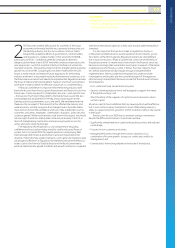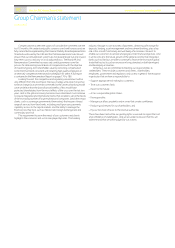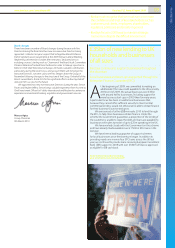Barclays 2009 Annual Report Download - page 18
Download and view the complete annual report
Please find page 18 of the 2009 Barclays annual report below. You can navigate through the pages in the report by either clicking on the pages listed below, or by using the keyword search tool below to find specific information within the annual report.
16 Barclays PLC Annual Report 2009 www.barclays.com/annualreport09
Group Chief Executive’s review
continued
There is a lot of focus from stakeholders on the willingness of banks to
lend, and of course availability of credit is a critical component of economic
stabilisation and regeneration. In April 2009, we said that we would make
an additional £11bn of lending available to UK households and businesses.
In fact, our gross new lending to UK households and businesses in 2009
totalled some £35bn, indicating both that we were open for business, and
that we were able to extend credit on terms which we regard as prudent.
Our retail and commercial banking businesses in GRCB – Western
Europe, where we now serve almost three million customers, have
continued to grow. In addition to the CNP joint venture and cards acquisition
in Portugal, we added nearly 100 new branches in Italy and 50 in Portugal
and attracted almost £8bn of new customer deposits as we increased our
focus on the asset:liability mix of our business flows in these markets. Our
task looking forward is to ensure this business produces sustainable profits,
which will require it to be less reliant on one-offs than it has been in the past
two years.
In the developing countries of the world in which we operate, our
performance in the ten mature markets of Africa and the Indian Ocean
where we are present has been strong. GRCB – Emerging Markets as a
whole made a loss. We now serve almost four million customers across
these markets, but we have been too aggressive in our approach to business
expansion here over the past two years. This business must now convert
investments made in the last three years (in terms of people, customer
recruitment and sales outlets) into sustainable profits.
GRCB – Absa performed resiliently in a very difficult economic
environment. Notable during the year was its ability to continue to grow
customer deposit balances, particularly for the South African consumer.
Our success in Barclays Capital is reflected both in the exceptional
revenue progress across 2009 and also in some of the client and market-
nominated awards which it has won over the year. These included Primary
Debt House of the Year from Euromoney, IFR Bond House of the Year,
Derivative House of the Year from Risk magazine and the Number 1 Ranking
for US Equity Research and US Fixed Income Research in the Annual
Institutional Investor All-America Team surveys.
In Barclays Wealth we continued to attract client assets at a time of great
uncertainty. Our intention for 2010 and beyond is to accelerate growth in the
High Net Worth businesses.
Managing Our Risks: As we expected, 2009 was another year of vicious
testing of our risk management. In February, we shared with the market our
planning assumption for loan loss rates for 2009, indicating that we
expected them to be in the range of 130 to 150 basis points, predicated on
certain macroeconomic assumptions. The economies of the world in
which we do business performed worse in 2009 than our central planning
case had projected at the beginning of the year. Despite that, our loan loss
rate was 135bps on a consistent basisa
, towards the bottom end of the
130-150bps range we planned for. This is evidence of the robust risk
management and planning procedures we have in place. And although
impairment rose significantly in 2009 versus 2008 (and in certain areas
of our business could rise further in 2010), a combination of strong income
and good cost control enabled us, though substantial profit generation,
to enter 2010 with our Core Tier 1 capital ratio at 10.0%. At the same time,
we reduced our leverage to 20x, from 28x, and our total assets by 33%,
and we increased the surplus of liquid assets in the balance sheet by £84bn.
Governments, regulators and banks are currently focused on many
of these metrics of financial and risk management health as they seek to
ensure that the excesses of the previous economic cycle, and the costs
of financial failure that have resulted from it, are not repeated. We support
these moves and are committed to adapting our business to the changes
that result.
Those reforms need to balance three things: the need for a safer
financial system, the importance of economic growth and the ability of
the suppliers of bank capital to earn appropriate returns. The achievement
of those twin objectives, which is so important to the world over the course
of the next decade, will be facilitated by a strong and supportive banking
system providing credit, managing risk and supporting innovation.
An important dimension of the reform agenda is that decisions about
investment banking are based on science and experience, not on rhetoric.
There has been much talk about ‘gambling by investment banks’. Barclays
Capital no more gambles in the work it does on behalf of its clients than
the clients do themselves. Its work is the work of risk management and
financing. Its job is to help governments, companies and investors around
the world raise money, stimulate economic growth, create employment,
and manage pensions and other savings. This is a real economy role.
Investment banking plays an important part in the universal banking
model that we have built in Barclays because many of those that we serve
need to have access to the capital markets, and because we cannot meet
their financing and risk management needs without having a strong advisory,
execution and trading capability within the Group. History and the current
crisis demonstrate that the performance of the capital markets businesses and
retail and commercial businesses is naturally asymmetrical. The asymmetry
of their respective income and impairment cycles provides a strong source of
resilience. The effects and benefits of that are very clear in the performance of
In 2009, Global Retail Banking (GRB) businesses
were resilient in unsettling and challenging
times. We have shown that we are strongly
positioned to build and grow in a tough
environment. For example, the acquisitions of
Standard Life Bank and Citigroup’s credit card
business in Portugal show our appetite and
capabilities to maximise on market opportunities,
whether through organic or inorganic growth.
Looking forward, I am very excited about the
potential for GRB in 2010 and beyond. We want to
be the best retail bank in our chosen markets and
to be seen as a leader in our industry. We want to
grow our non-UK business and increase, over
time, the ratio of non-UK to UK business. The
emphasis is on creating critical mass in markets
where we have a greater presence. Our ambition
is depth, not breadth.
To help us achieve this, our key priorities for
this year are:
– Profit growth and profit diversification;
– Improving our liquidity – the ratio between loans
and deposits;
– Deeper penetration of our existing markets and
international diversification; and
– Generation of net equity.
Delivering on these priorities and ensuring that
we maintain control over every aspect of our
operations are key to achieving our ambitions
and strategy. The external environment has been
extremely difficult, but when the cycle turns, the
profits of GRB and its contribution to Barclays
Group will shift significantly.
Antony Jenkins
Chief Executive,
Global Retail Banking
November 2009:
Regrouping of activities Global Retail Banking
























